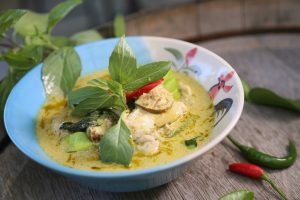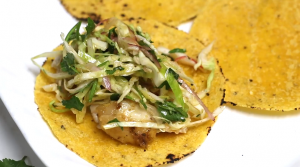Experience the vibrant flavors of Thai cuisine in your own kitchen with this Thai Green Curry with Spring Vegetables recipe. Fresh asparagus, carrots, and baby spinach are simmered in a fragrant coconut milk and green curry paste sauce, delivering an authentic, aromatic dish that's loaded with nutrients and taste. The best part? It's all cooked in one pan, making it an ideal weeknight dinner option.
Thai green curry paste is a unique ingredient that might not be in your pantry but is essential for this dish. It's available in most supermarkets in the international foods section. It's loaded with intense flavors like lemongrass, green chilies, and kaffir lime leaves that make this curry dish distinctly Thai. Coconut milk is another key ingredient that lends its rich and creamy texture and subtle sweetness to the curry. The remaining ingredients are everyday vegetables and seasonings.
Ingredients for Thai Green Curry with Spring Vegetables
Brown basmati rice: A whole grain that adds a nutty flavor and hearty texture.
Coconut oil: Used for sautéing and adds a subtle coconut flavor.
White onion: Adds a sweet and savory flavor to the curry.
Fresh ginger: Provides a warm and zesty kick.
Garlic cloves: Gives depth and aroma to the dish.
Asparagus: Spring vegetable that adds a delicious crunch.
Carrots: Adds sweetness and vibrant color.
Thai green curry paste: The heart of Thai curry dishes, providing intense flavor.
Coconut milk: Adds creaminess and subtle sweetness to the curry.
Coconut sugar: Adds a hint of sweetness to balance the heat.
Baby spinach: Nutritious leafy green that wilts into the curry.
Rice vinegar: Adds a slight tang to the curry.
Soy sauce: Salty and umami flavor enhancer.
Fresh cilantro: Adds a fresh, herby garnish.
Red pepper flakes: Optional, for added heat and flavor.
One reader, Demetria Canada says:





This Thai green curry recipe is a game-changer! The blend of fresh spring vegetables with the aromatic curry paste creates a burst of flavors that's simply divine. The creamy coconut milk adds a luxurious touch, making it a comforting and satisfying dish. It's a must-try for anyone craving a taste of Thailand!
Mastering the Techniques for Thai Green Curry with Spring Vegetables
How to cook brown basmati rice: Boil the rice in a large pot of water for 30 minutes, then drain and let it rest for 10 minutes before serving.
How to sauté vegetables: Cook the onion, ginger, garlic, asparagus, and carrots in a skillet with coconut oil over medium heat until tender.
How to make green curry paste: Combine the Thai green curry paste with the coconut milk, water, and coconut sugar in the skillet and simmer until the vegetables are cooked through.
How to wilt spinach: Stir the spinach into the curry mixture and cook for about 30 seconds until the spinach has wilted.
How to season the curry: Remove the curry from heat and season with rice vinegar, soy sauce, salt, and red pepper flakes to taste.
How to garnish: Divide the rice and curry into bowls and garnish with chopped cilantro and a sprinkle of red pepper flakes.
How To Make Thai Green Curry with Spring Vegetables
End your day with a creamy Thai green curry for dinner. This dish consists of asparagus, carrots, and spinach in rich green coconut sauce.
Serves:
Ingredients
- 1cupbrown basmati ricerinsed
- 2tspcoconut oilor olive oil
- 1white onionsmall, diced
- 1tbspfresh gingerfinely chopped
- 2garlic clovesfinely chopped
- salt
- ½bunchasparagustough ends removed and sliced into 2-inch long pieces
- 3carrotspeeled and sliced on the diagonal into ¼-inch wide rounds
- 2tbspThai green curry paste
- 14ozcoconut milk
- ½cupwater
- 1½tspcoconut sugaror turbinado (raw) sugar or brown sugar
- 2cupspacked baby spinachroughly chopped
- 1½tsprice vinegaror fresh lime juice
- 1½tspsoy sauce
- a handful of chopped fresh cilantrofor garnish
- red pepper flakesto taste
Instructions
-
Bring a large pot of water to boil. Add the rinsed rice and continue boiling for 30 minutes, reducing heat as necessary to prevent overflow.
-
Remove from heat, drain the rice, and return the rice to the pot.
-
Cover and let the rice rest for 10 minutes or longer, until ready to serve.
-
Warm a large skillet with deep sides over medium heat. Once it’s hot, add a couple of teaspoons of oil.
-
Cook the onion, ginger, and garlic with a sprinkle of salt for about 5 minutes, stirring often. Add the asparagus and carrots and cook for 3 more minutes, stirring occasionally. Then add the curry paste and cook, stirring often, for 2 minutes.
-
Pour the coconut milk into the pan, along with water and sugar. Bring the mixture to a simmer. Reduce heat as necessary to maintain a gentle simmer and cook for about 5 to 10 minutes until the carrots and asparagus are tender and cooked through.
-
Once the vegetables are done cooking, stir the spinach into the mixture and cook for about 30 seconds until the spinach has wilted.
-
Remove the curry from heat and season with rice vinegar and soy sauce. Add salt and red pepper flakes (optional), to taste.
-
Divide rice and curry into bowls and garnish with chopped cilantro and a sprinkle of red pepper flakes.
Nutrition
- Calories: 444.54kcal
- Fat: 25.44g
- Saturated Fat: 21.09g
- Monounsaturated Fat: 1.75g
- Polyunsaturated Fat: 0.99g
- Carbohydrates: 50.92g
- Fiber: 4.62g
- Sugar: 6.12g
- Protein: 7.95g
- Cholesterol: 0.74mg
- Sodium: 711.65mg
- Calcium: 76.11mg
- Potassium: 682.89mg
- Iron: 5.36mg
- Vitamin A: 429.60µg
- Vitamin C: 11.63mg
Crucial Technique for Perfecting Thai Green Curry
When cooking the asparagus and carrots, it's important to not overcook them. These vegetables should retain a slight crunch to contrast with the creamy coconut milk based curry. Overcooking them can result in a mushy texture that doesn't complement the dish well. Also, when adding the spinach, remember it wilts quickly, so it's best to add it towards the end of the cooking process. This will ensure it retains its vibrant green color and fresh taste.
Time-Saving Tips for Making Thai Green Curry
Prep ahead: Chop and prepare all the vegetables and ingredients in advance to streamline the cooking process.
One-pot wonder: Consider using a large skillet or pot to cook the entire dish, minimizing the number of dishes to clean up afterward.
Quick-cooking rice: Opt for quick-cooking rice varieties or pre-cooked rice to reduce the overall cooking time.
Efficient multitasking: While the rice is cooking, simultaneously prepare the curry to save time and ensure both components are ready together.
Store-bought curry paste: Utilize store-bought Thai green curry paste for convenience without compromising on flavor.
Frozen vegetables: Incorporate frozen vegetables for a time-saving alternative, as they require minimal prep work and cook quickly.
Substitute Ingredients For Thai Green Curry with Spring Vegetables Recipe
brown basmati rice - Substitute with quinoa: Quinoa is a great gluten-free alternative to rice and adds a nutty flavor to the dish.
coconut oil - Substitute with vegetable oil: Vegetable oil can be used as a neutral substitute for coconut oil in this recipe.
white onion - Substitute with yellow onion: Yellow onions have a slightly stronger flavor than white onions but can be used as a substitute in this recipe.
fresh ginger - Substitute with ground ginger: Ground ginger can be used as a substitute for fresh ginger in this recipe, but use it sparingly as it is more concentrated in flavor.
garlic cloves - Substitute with garlic powder: Garlic powder can be used as a substitute for fresh garlic cloves, but adjust the quantity to taste.
asparagus - Substitute with green beans: Green beans can be used as a substitute for asparagus, providing a similar texture and flavor to the dish.
carrots - Substitute with bell peppers: Bell peppers can add a sweet and crunchy element as a substitute for carrots in this recipe.
thai green curry paste - Substitute with yellow curry paste: Yellow curry paste can be used as a substitute for green curry paste, offering a different flavor profile but still complementing the dish.
coconut milk - Substitute with almond milk: Almond milk can be used as a substitute for coconut milk for a lighter, nuttier flavor in the dish.
baby spinach - Substitute with kale: Kale can be used as a substitute for baby spinach, providing a heartier texture and earthy flavor to the dish.
rice vinegar - Substitute with white wine vinegar: White wine vinegar can be used as a substitute for rice vinegar, providing a similar level of acidity to the dish.
soy sauce - Substitute with tamari: Tamari, a gluten-free soy sauce alternative, can be used as a substitute for soy sauce in this recipe.
fresh cilantro - Substitute with fresh parsley: Fresh parsley can be used as a substitute for cilantro, providing a similar fresh and herbaceous flavor to the dish.
red pepper flakes - Substitute with cayenne pepper: Cayenne pepper can be used as a substitute for red pepper flakes, adding a spicy kick to the dish.
Elevate Your Thai Green Curry Presentation
Elevate the rice: Mold the brown basmati rice into a small circular shape using a ring mold for a refined presentation. Place it neatly at the center of the plate using a spatula for a clean and elegant look.
Garnish with cilantro: Sprinkle freshly chopped cilantro over the curry in a deliberate and artistic manner. This will add a pop of color and a burst of fresh flavor to the dish.
Create a vibrant curry swirl: Use a small ladle to carefully create a swirl of the Thai green curry on the plate. This technique adds a touch of sophistication and visual appeal to the dish.
Incorporate edible flowers: Introduce a few edible flowers, such as nasturtium or pansies, to the plate for a delicate and visually stunning touch. Ensure that the flowers complement the flavors of the dish.
Utilize microgreens: Sprinkle a few delicate microgreens over the curry for a subtle yet impactful touch of freshness and visual interest.
Add a dash of red pepper flakes: Sprinkle a small amount of red pepper flakes around the edge of the plate for a hint of color and a touch of heat. This adds visual intrigue and a hint of excitement to the presentation.
Plate with precision: Use tweezers to carefully place the asparagus and carrot pieces on the plate, ensuring each element is positioned thoughtfully and with attention to detail.
Consider the negative space: Embrace the concept of negative space on the plate to allow the vibrant colors and textures of the dish to take center stage. Ensure that the presentation feels balanced and visually appealing.
Essential Tools for Making Thai Green Curry
- Large pot: Used for boiling rice and other large quantities of food.
- Skillet: A versatile pan used for sautéing, frying, and simmering ingredients.
- Deep-sided skillet: Ideal for cooking dishes with a lot of liquid or ingredients.
- Food processor: Useful for chopping, blending, and pureeing ingredients.
- Mixing bowl: Essential for combining and mixing various ingredients.
- Spatula: Used for stirring, flipping, and serving food.
- Knife: Essential for chopping and preparing vegetables and other ingredients.
- Cutting board: Provides a stable surface for cutting and preparing ingredients.
- Measuring spoons: Used for accurately measuring small amounts of ingredients.
- Measuring cups: Essential for accurately measuring larger quantities of ingredients.
- Wooden spoon: Ideal for stirring and mixing ingredients, especially in hot dishes.
- Ladle: Used for serving soups, stews, and other liquid-based dishes.
- Rice cooker: Optional, but can be used for cooking rice to perfection.
Storing and Freezing Thai Green Curry
- To store leftover thai green curry, allow it to cool completely to room temperature before transferring it to an airtight container. Refrigerate for up to 3-4 days.
- When reheating, add a splash of coconut milk or water to help loosen the sauce and prevent it from drying out. Reheat gently in a saucepan over medium-low heat, stirring occasionally, until warmed through.
- For longer storage, you can freeze the curry for up to 2-3 months. Transfer the cooled curry to a freezer-safe container or resealable plastic bag, removing as much air as possible before sealing.
- To thaw frozen curry, place it in the refrigerator overnight or use the defrost setting on your microwave. Once thawed, reheat the curry in a saucepan over medium-low heat, stirring occasionally and adding a little extra coconut milk or water if needed to achieve the desired consistency.
- It's best to store the rice separately from the curry, as it tends to absorb excess moisture and become mushy when stored together. If you have leftover rice, store it in a separate airtight container in the refrigerator for up to 4-5 days.
- To reheat refrigerated rice, add a splash of water and microwave in 30-second intervals, stirring between each interval, until heated through. Alternatively, you can reheat the rice in a saucepan over medium-low heat with a splash of water, stirring occasionally, until warmed through and slightly steaming.
How To Reheat Leftover Thai Green Curry
Reheat the curry in a saucepan over medium-low heat, stirring occasionally until it's heated through. This method ensures the flavors meld together and the vegetables maintain their texture. If the curry seems too thick, add a splash of coconut milk or water to thin it out.
For a quicker option, reheat individual portions in the microwave. Place the desired amount of curry in a microwave-safe bowl, cover with a damp paper towel, and heat in 30-second intervals, stirring between each interval, until heated through. This method is fast but may result in slightly overcooked vegetables.
If you have leftover rice, you can reheat it in the microwave as well. Place the rice in a microwave-safe bowl, add a splash of water, and cover with a damp paper towel. Heat for 1-2 minutes, or until heated through, fluffing the rice with a fork halfway through.
For a crispy twist, transform your leftover curry into a stir-fry. Heat a tablespoon of oil in a large skillet or wok, add the leftover curry and rice, and stir-fry over high heat for 3-4 minutes, or until the rice is crispy and the curry is heated through. This method adds a new texture to the dish and refreshes the flavors.
If you have an oven-safe dish, you can reheat the curry in the oven. Preheat the oven to 350°F (175°C), transfer the curry to the dish, cover with foil, and bake for 15-20 minutes, or until heated through. This method is ideal if you're reheating a large quantity of curry.
Fascinating Facts About Thai Green Curry
The Thai green curry with spring vegetables recipe is a delicious and nutritious dish that combines the flavors of coconut milk, fresh vegetables, and aromatic spices. This dish is a great source of vitamins and minerals, and it's also a wonderful way to incorporate more plant-based meals into your diet. The combination of asparagus, carrots, and spinach provides a variety of textures and flavors, making it a satisfying and wholesome meal. Additionally, the use of Thai green curry paste adds a unique and authentic taste to the dish, making it a flavorful and enjoyable dining experience.
Is Making Thai Green Curry at Home Cost-Effective?
This Thai green curry with spring vegetables recipe is quite cost-effective for a household. The main ingredients, such as rice, vegetables, coconut milk, and curry paste, are generally affordable and widely available. The dish offers a delightful blend of flavors and textures, making it a satisfying and wholesome meal. I would rate this recipe an 8 for its balance of affordability and taste. The approximate cost for a household of 4 people would be around $15-$20, making it a budget-friendly option for a flavorful and nutritious dinner.
Is Thai Green Curry with Spring Vegetables Healthy?
This Thai green curry with spring vegetables recipe is a nutritious and well-balanced meal. The dish incorporates a variety of vegetables, including asparagus, carrots, and spinach, which provide essential vitamins, minerals, and fiber. Brown basmati rice is a whole grain that offers complex carbohydrates and additional fiber. The use of coconut milk and oil contributes healthy fats to the dish, while the limited amount of coconut sugar and soy sauce helps keep the sodium and added sugar content in check.
To further enhance the nutritional value of this recipe, consider the following suggestions:
- Increase the variety of vegetables by adding bell peppers, zucchini, or snap peas to boost the fiber, vitamin, and mineral content
- Replace the coconut milk with a reduced-fat version or use half coconut milk and half vegetable broth to lower the calorie and saturated fat content
- Incorporate a lean protein source, such as tofu, chicken, or shrimp, to make the meal more satiating and balanced
- Reduce the amount of coconut sugar or replace it with a natural sweetener like stevia or monk fruit extract to minimize added sugars
- Garnish with fresh herbs like Thai basil or mint to add bright, fresh flavors without additional calories
Editor's Take on This Thai Green Curry Recipe
The recipe for Thai green curry with spring vegetables is a delightful combination of fresh, vibrant flavors and wholesome ingredients. The use of coconut milk, Thai green curry paste, and a variety of vegetables creates a harmonious balance of sweet, savory, and spicy notes. The addition of brown basmati rice provides a nutritious and hearty base for the curry. The cooking instructions are clear and easy to follow, making this recipe accessible for home cooks of all skill levels. Overall, this dish is a perfect choice for a satisfying and nourishing meal that celebrates the beauty of spring produce.
Enhance Your Thai Green Curry with Spring Vegetables Recipe with These Unique Side Dishes:
Delicious Alternatives to Thai Green Curry
Perfect Appetizers and Desserts for Thai Green Curry
Why trust this Thai Green Curry with Spring Vegetables Recipe:
This Thai green curry with spring vegetables recipe offers a delightful combination of fresh, vibrant flavors and wholesome ingredients. The use of thai green curry paste and coconut milk ensures an authentic and rich taste, while the addition of asparagus and carrots provides a nutritious and colorful twist. The recipe's careful balance of rice vinegar and soy sauce enhances the overall depth of flavor, promising a satisfying dining experience. With its detailed instructions and thoughtful selection of ingredients, this recipe is a trustworthy choice for those seeking a delicious and nourishing culinary adventure.
Was this page helpful?
Have your own special recipe to share? Submit Your Recipe Today!














